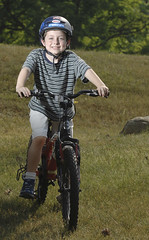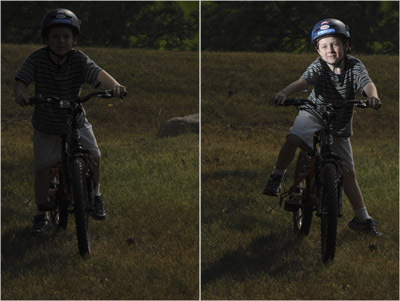_______________________________________
 We recently lucked into a good deal on a used Trek MT60 mountain bike for my son Ben. We are big believers in buying better quality used, rather than cheaper-made stuff new. And I am proud that my 6-year-old is already choosing quality and value over shiny, cheap and new.
We recently lucked into a good deal on a used Trek MT60 mountain bike for my son Ben. We are big believers in buying better quality used, rather than cheaper-made stuff new. And I am proud that my 6-year-old is already choosing quality and value over shiny, cheap and new.But a new bike, even if it is not really new, means doing a picture of him on it to email down to Nana and Papa Ken.
I shot a typical, quickie two-light setup. The first light was the sun, from behind and over Ben's camera right shoulder. The second was an SB-26 on a stand at camera left. It's easy to balance with the sun when shooting with a small flash at close range. And even at 1/4 power on the SB-26 there was plenty of off-camera fill at 1/250th of a sec.
But to raise that shutter speed even more, you have to try a little partial-frame syncing. This is a technique in which you only have the flash lighting part of your frame, with the trade-off being higher sync speeds.
As with the electronic shutter trick, you'll have to fool your camera into not knowing that there is a flash up top. Check back on part one for the how-to info. (Basically, it means no on-camera flash unless you insulate the TTL contacts, and no use of a TTL off-camera cord. Anything else - PC cord, remotes, etc, is cool.)
To give you an idea of how it works I set up an SB-26 on a stand, aimed at the wall, and started playing with the shutter on my D2Xs, which nominally syncs at 1/250th of a sec.
 Here we are at 1/250th. No surprises here. The camera is supposed to sync at 1/250th and it does, with no blocked areas.
Here we are at 1/250th. No surprises here. The camera is supposed to sync at 1/250th and it does, with no blocked areas. But what happens as we take a walk up the shutter speed scale?
 As you can see, 1/320th is almost totally synched. That's because there is a little margin for error built into the system. But as we go up higher, you can see that there is still some flash-lit compositional room in which to play. And I frequently make use of higher speed by composing so the lit part of my subject is in the band of the frame that gets the partial sync.
As you can see, 1/320th is almost totally synched. That's because there is a little margin for error built into the system. But as we go up higher, you can see that there is still some flash-lit compositional room in which to play. And I frequently make use of higher speed by composing so the lit part of my subject is in the band of the frame that gets the partial sync. Interestingly, you'll note that in this test the 1/640th test frame shows more sync area than the 1/500th. There is some variability in this technique from frame to frame, and you should allow for a little bit of a fudge factor when composing.
On my camera, the good band is at the bottom of the frame when held in a normal, horizontal position. Your camera may be different, due to different shutter designs, so you'll wanna check.
With a little compositional planning, I can comfortably sync up to 1/1000th and still get some good, usable real estate for my flash. Mind you, the electronic shutter trick is better as it gives you full sync. And the focal plane flash thing rocks if your gear supports it. But to some degree, this trick works with most any camera and flash. So you can always fall back on it.
You might think that a half-frame of flash-lit area is useless. But remember that in a high-speed sync situation, you are almost certainly basing your exposure on the ambient (even if you have knocked it down a stop) and lighting your subject somewhere in the frame.
It is easier than you think to pull this off when you need to raise your shutter speed, open your aperture and make your flash more powerful. The ability to overpower the sun in mid-afternoon is a cool thing.
For instance, if I am shooting BMX bikers going over jumps, I would light the area where they hang in the air and shoot at 1/1000th of a sec with my camera held upside down. Remember, my sweet spot is on the bottom of the frame.
If that sounds too acrobatic for you, try it. If you have a vertical release, it is cake. Really.
 As an example, here is Ben shot at a 500th of a sec, which is a full stop past my sync speed. I have the flash zoomed to just light him from up top. As you can see, he syncs fine in the right hand composition, but not when he is on the left.
As an example, here is Ben shot at a 500th of a sec, which is a full stop past my sync speed. I have the flash zoomed to just light him from up top. As you can see, he syncs fine in the right hand composition, but not when he is on the left.I could easily reverse this by rotating the camera to the alternative vertical orientation, i.e. trigger finger on the bottom rather than the top. And note that you cannot see the sync line, as the exposure is based on the (underexposed) ambient light.
Sure, you may have to jump through some compositional hoops with this trick. But it gives you the ability to really nuke daylight when you have to. All you have to do is try a bit of planning with your composition.
And you do not have to spring for a focal-plane flash setup or a camera with an electronic shutter. Which leaves more money for used bikes.




0 comments:
Post a Comment